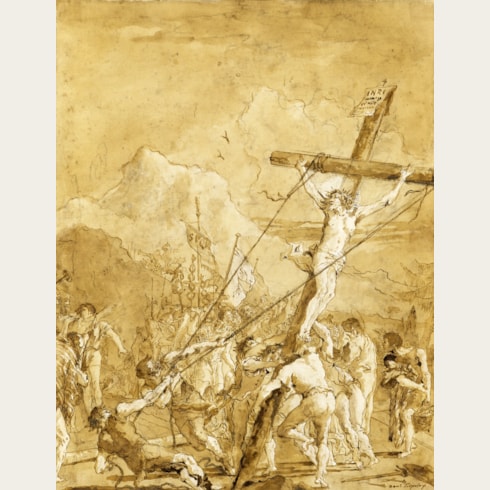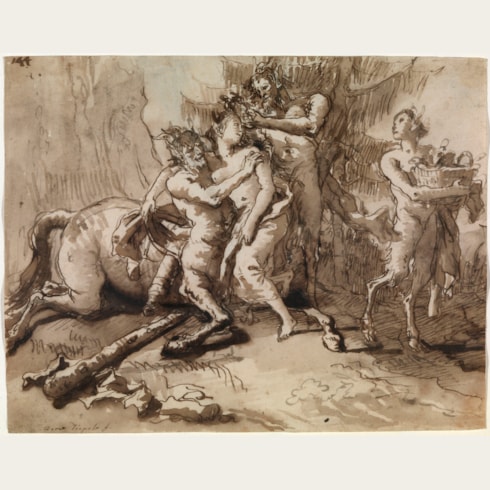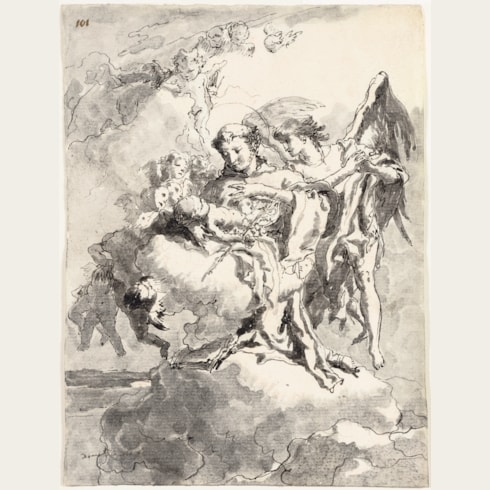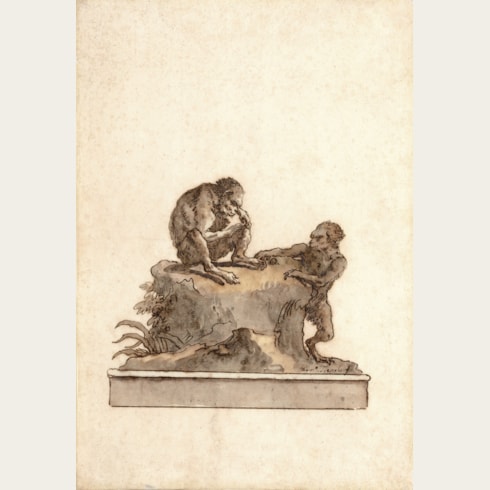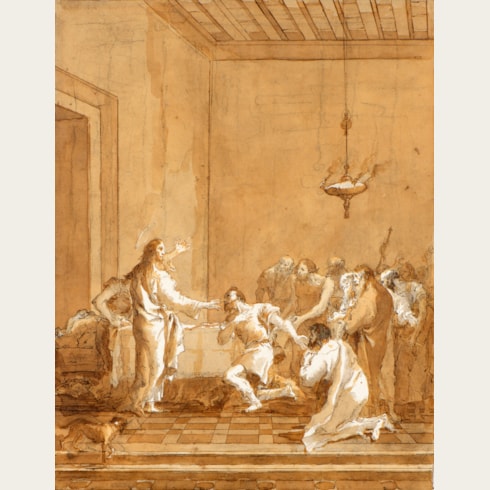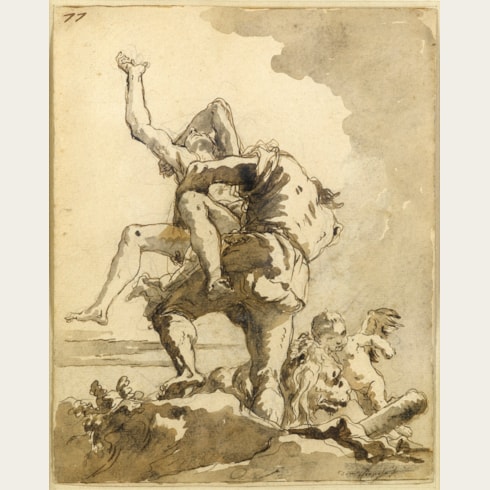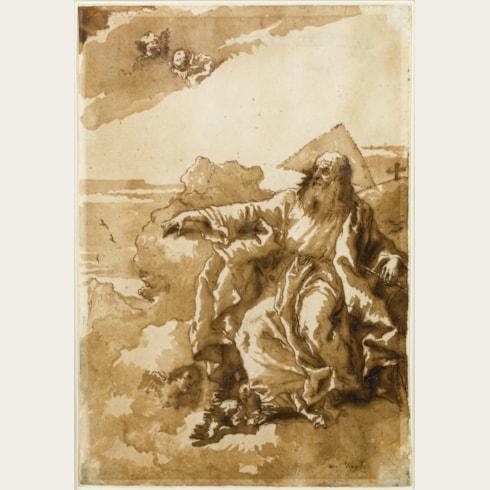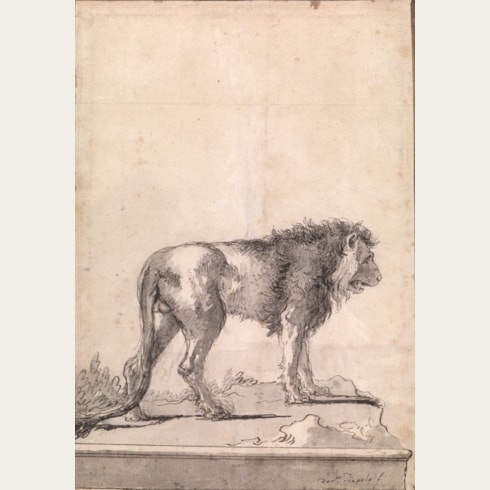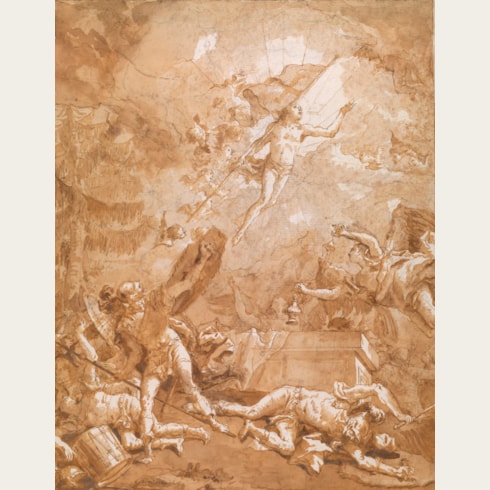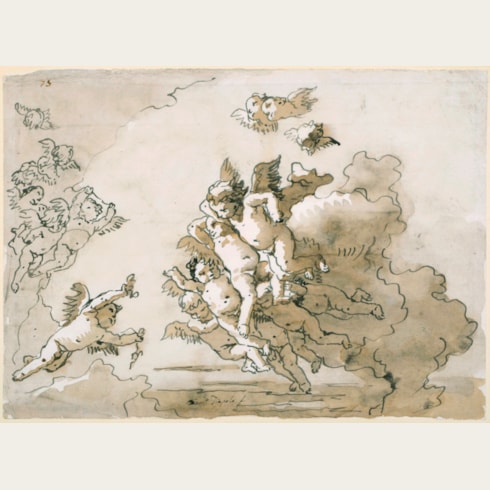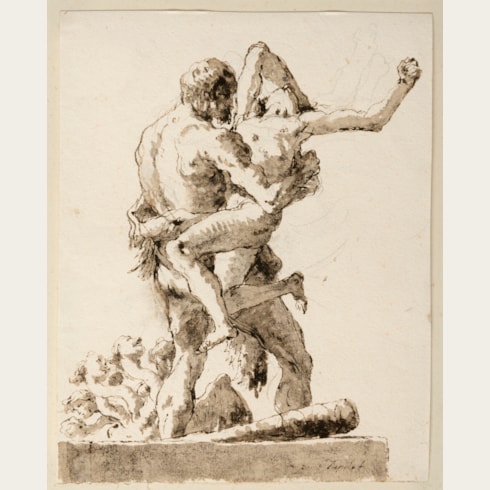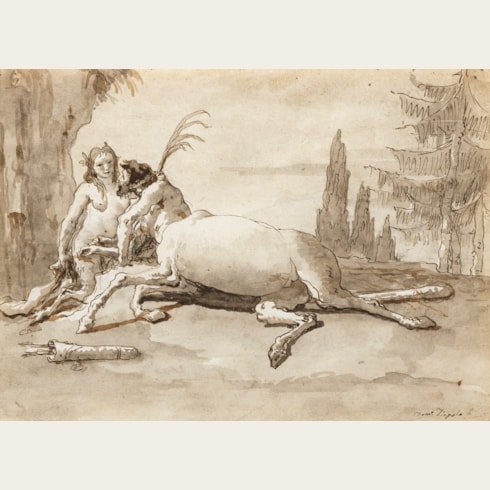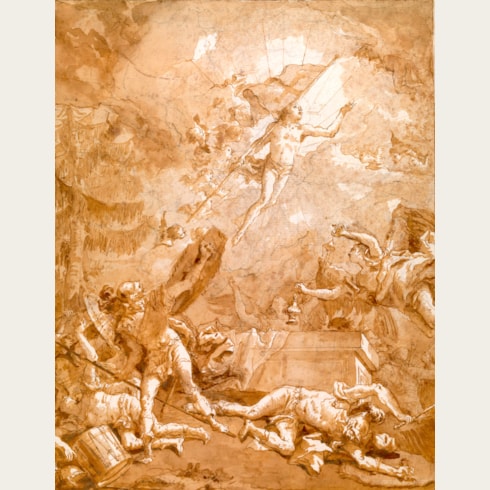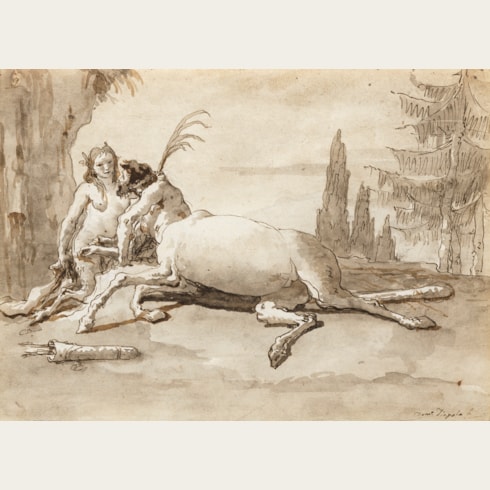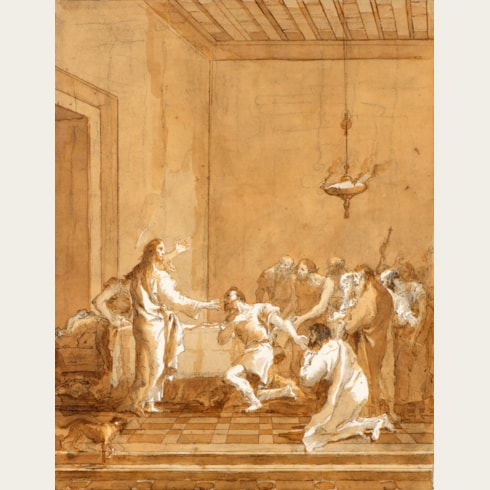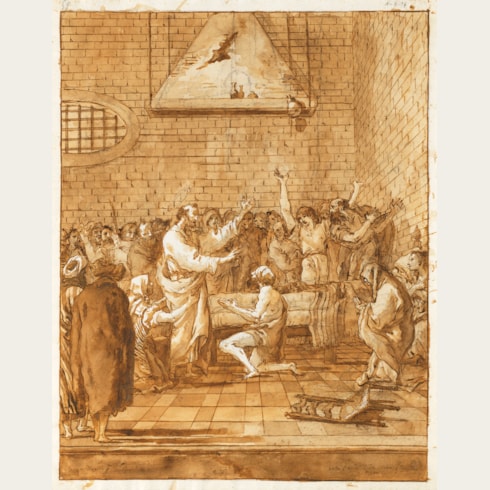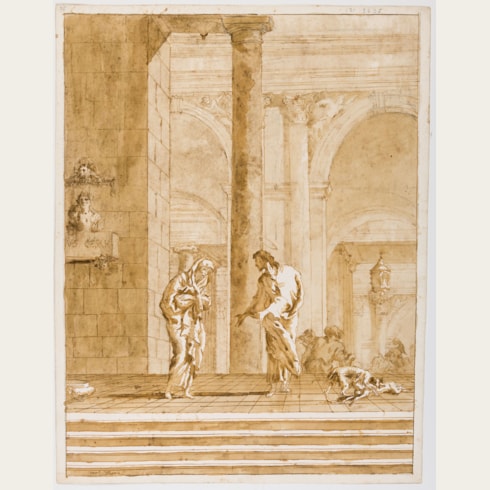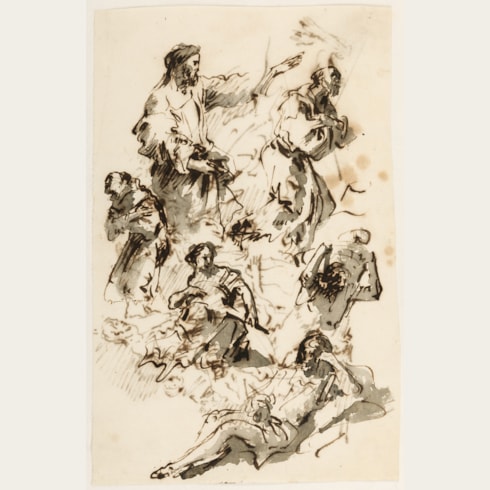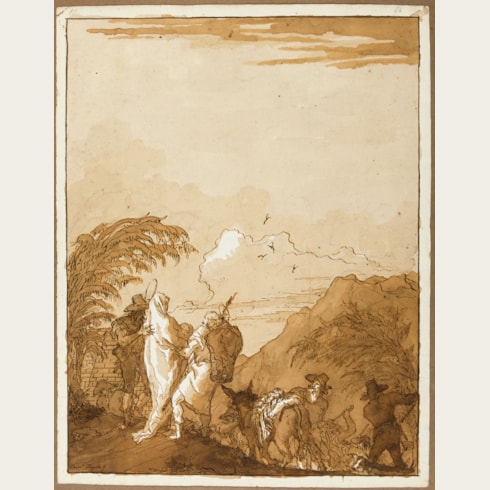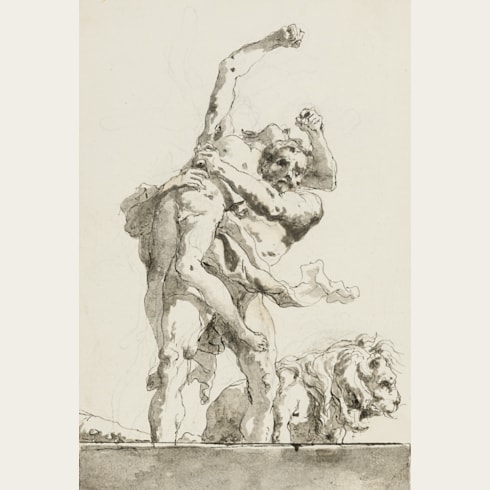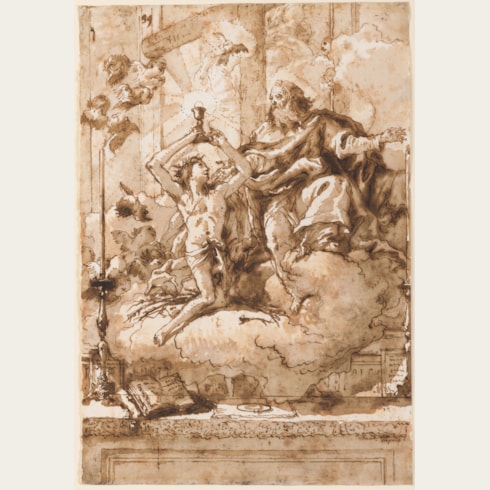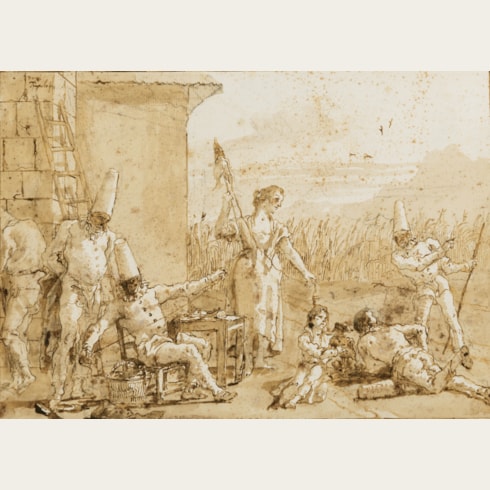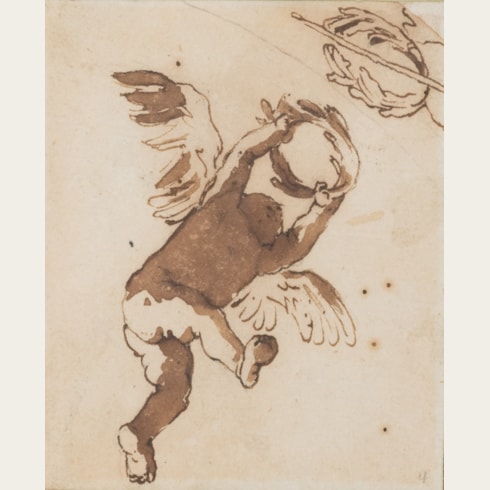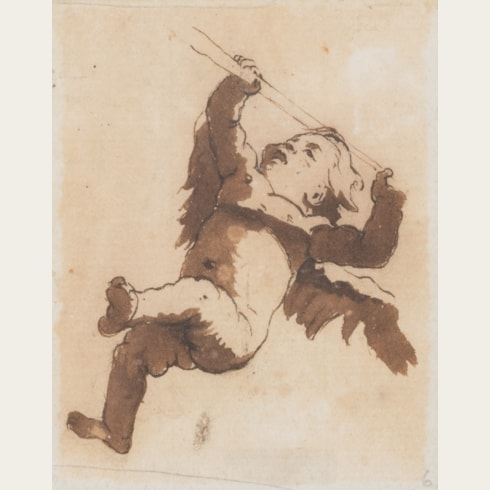Giovanni Domenico TIEPOLO
(Venice 1727 - Venice 1804)
The Carpenter’s Shop
Signed Domo. Tiepolo f at the lower left and numbered 56 in the upper left margin.
294 x 411 mm. (11 5/8 x 16 1/4 in.) [image]
350 x 468 mm. (13 3/4 x 18 3/6 in.) [sheet]
Following the fall of the Venetian Republic to Napoleon in 1797, Domenico Tiepolo’s final years were devoted entirely to drawing, and his oeuvre as a draughtsman reached its peak in the celebrated series of 104 drawings entitled the Divertimenti per li regazzi (‘Amusements for the Young’). Illustrating scenes from the life of Punchinello, a popular character from the Commedia dell’Arte, the series appears to have occupied the artist from the later 1790s through to the first years of the 19th century. They have become the most admired and prized of all of the artist’s drawings. As Catherine Whistler has noted, ‘Domenico’s spirited and inventive independent sheets have long been appreciated, particularly by French and American collectors of the late nineteenth and early twentieth centuries; his quirky sense of humor, acutely observant eye, and zestful approach to his subjects lend his drawings a peculiarly modern appeal.’1
The ribald character of Punchinello (known in Italian as Pulcinella) - with his large hooked nose, hunched back and bulging belly, black mask, white suit and conical hat - was popular among artists in Venice in the 18th century, and had been treated earlier in drawings and paintings by both Giambattista and Domenico Tiepolo. The drawings of the Divertimenti per li regazzi, however, represent by far the most thorough and varied treatment of the subject by any Italian artist. No literary text is known from which Domenico could have based his drawings, and the narrative of the series appears to have been entirely his own invention. All but ten of these large drawings are signed, and, like the same artist’s ‘Large Biblical Series’ and the ‘Scenes of Contemporary Life’, they must have been intended as independent works of art.
While it has proved difficult to place the drawings of the Divertimenti per li regazzi in any kind of strict sequential order, they can, as the scholar James Byam Shaw has noted, be divided into five basic groups. The first set of drawings examines the parents, childhood and youth of Punchinello, while the second group depicts his various occupations; as a painter, tailor, wine merchant, circus acrobat and so forth. (The present sheet belongs with this group.) These are followed by scenes illustrating Punchinello’s visits to strange countries, his social and official life and, finally, his illness and death.
One of twelve drawings from the Punchinello series which was until recently in the collection of Sir Brinsley Ford and his descendants, this large sheet, as has been noted, may be grouped with a number of drawings from the Divertimenti per li regazzi series that depict the various trades and occupations of Punchinello. As Adelheid Gealt has described the scene: ‘Here Punchinellos labor at transforming rough lumber into ornate, delicate furnishings like the bureau, basin tray and corner piece admired by Punchinello customers. As a laborer brings a liquid (perhaps oil or sizing?), several other assistants are busily occupied with their trade, depicted in a marvelous sequence: one selects a plank, another saws it down, while another takes measurements – but of what? – all under the exacting scrutiny of the master. Carpenter’s tools, lovingly described, are strewn about. This suggests again that all aspects of the woodworking trade must have been close to Domenico’s own experience, as he must have done business with woodworkers on many occasions.’2
As the same author has also pointed out, ‘lumber – for easels, stretchers and frames – is an essential ingredient in a painter’s life, and the artist must have visited any number of rural lumber yards and city carpentry shops to obtain materials.’ It may further be noted that the present sheet, which is numbered 56, is preceded in the numerical sequence of Divertimenti per li regazzi drawings by several other scenes of Punchinellos gathering, chopping or sawing wood. Many of the same features of a carpentry workshop likewise appear in two drawings by Domenico Tiepolo from his ‘Large Biblical Series’; one depicting Joseph Taking Leave of Mary, whose present location is currently unknown, and another of Mary Disclosing the Angel Gabriel’s Message to Joseph (or Joseph Scolding Mary), formerly in the Heinemann collection and now in the Pierpont Morgan Library in New York6. Both drawings show the same brick walls, oval grilled window and wooden planks stacked against the wall as seen in the present sheet, together with a discarded hammer lying on the ground.
Arguably Domenico Tiepolo’s greatest achievement as a draughtsman, executed when he was in his seventies, the Punchinello series found the artist exploiting his visual vocabulary to its fullest effect. As Byam Shaw has observed, ‘the fertility of invention and skill in composition displayed in this long series is wonderful; the unobtrusive satire, the topical anecdote, and the fantastic liveliness of the whole work make a place for Domenico all his own, out of the shadow of his great father, in the history of comic drawing; and if a series of etchings was intended, it is a pity indeed that it was never carried out.’ This charming sheet, in splendid condition, must be considered one of the finest of this remarkable series of large drawings, which have been so aptly described by Byam Shaw as ‘the most desired and the most desirable of all Domenico’s works.’
The series of 104 Punchinello drawings of the Divertimenti per li regazzi, which includes a title page, may well have been assembled into an album. When the drawings first appeared on the market, at auction in London in 1920, however, they were not bound into an album but were displayed as loose sheets. The entire group of Punchinello drawings was purchased at the auction by the London gallery Colnaghi, and six months later was in turn sold to the British art dealer Richard Owen (d.1951), who was based in Paris in the 1920s and 1930s. After the complete series was exhibited by Owen at the Musée des Arts Décoratifs in 1921, the drawings were sold individually by him and dispersed. The present sheet was one of several drawings from the Punchinello series purchased from Owen by the Italian politician, collector and occasional art dealer Count Alessandro Contini-Bonacossi (1878-1955).
The Carpenter’s Shop was part of a group of fourteen Punchinello drawings acquired in 1936, when he was in his twenties, by the art historian and collector Brinsley Ford (1908-1999). As Ford later recalled many years later, writing at the age of eighty-nine, ‘In the latter part of 1936, and early in 1937, I was fortunate to buy fourteen, from the famous set of 104 Punchinello drawings. Four I bought from Count Alessandro Contini in Florence for £400, and ten from the Matthiesen Gallery at £70 each. In 1954 I sold two for £670, and the remaining twelve form the principal feature on the walls of our small library…I cannot leave this major addition to the collection without giving some idea of the delight that these drawings have given me…The most remarkable features of this series are the extraordinary fertility of Domenico’s imagination and invention in scenes which range from riotous gaiety to the squalid and macabre, from the joys of childhood to the sufferings of old age, from realism to flights of fancy…What is also so memorable about the drawings is the brilliance and diversity of the compositions, for which the distorted shapes of the Punchinellos, with their sugar-loaf hats, lend themselves admirably…Domenico’s handling of washes is little short of magical, for he uses it to cast a golden glow across the page, and not infrequently he enriches the composition by introducing a diagonal line which demarcates an area in a darker tone, and this makes a perfect foil to the whiteness of Punchinello’s clothes. The motif that recurs most frequently in the drawings, in fact in about half of them, is the striped material which appears in the women’s dresses and shawls, and in the men’s jackets, trousers and stockings. This recurring motif, with the wicker baskets and tiny dogs that reappear with such frequency, unite to give the series a homogeneous character. It was this striped motif which appears with such frequency in the drawings that prompted me to choose as a background for them a blue striped flocked wallpaper.’
All twelve of the Punchinello drawings from the Brinsley Ford collection, including the present sheet, were exhibited together at the Palazzo Ducale in Venice in 2019.
Giovanni Domenico Tiepolo is assumed to have begun his career in the family studio by copying his father’s drawings, although he also created his own drawings as designs for etchings, a practice which occupied much of his time in the 1740s and 1750s. His first independent drawings for paintings are those related to a series of fourteen paintings of the Stations of the Cross for the Venetian church of San Polo, completed when he was just twenty. Between 1750 and 1770, Domenico worked closely with his father as an assistant, notably in Würzburg, at the Villa Valmarana in Vicenza and the Villa Pisani at Strà, and in Madrid. From the late 1740s he also began to be entrusted with his own independent commissions, and the drawings for these display a manner somewhat different from that of his father, with a particular interest in lighthearted genre motifs.
Soon after Giambattista Tiepolo’s sudden death in Madrid in 1770, Domenico returned to his native Venice, where he enjoyed much success as a decorative painter. He continued to expound the grand manner of history painting established by his father - the ‘Tiepolo style’, as it were – and by 1780 his reputation was such that he was named president of the Accademia di Belle Arti in Venice. Within a few years, however, he seems to have largely abandoned painting. In his sixties and living effectively in retirement at the Tiepolo family villa at Zianigo, on the Venetian mainland, he produced a large number of pen and wash drawings that are a testament to his inexhaustible gift for compositional invention.
For much of the last twenty years of his career, Domenico Tiepolo seems to have painted only occasionally, and instead worked primarily as a draughtsman, producing a large number of pen and wash drawings that may collectively be regarded as perhaps his finest artistic legacy. These drawings were, for the most part, executed as a series of several dozen or more themed drawings, many of which were numbered. Among these are several series of drawings of religious and mythological subjects, as well as a varied group of genre scenes, numbering around a hundred sheets, generally referred to as the so-called ‘Scenes of Contemporary Life’, and a celebrated series of 104 drawings entitled the Divertimenti per li regazzi, illustrating scenes from the life of Punchinello, a popular character from the Commedia dell’Arte.
Domenico’s highly finished late drawings, almost all of which were signed, were undoubtedly intended as fully realized, autonomous works of art. While it is certainly possible that they were produced as works of art to be offered for sale to collectors, almost none of the drawings appear to have been dispersed in Domenico’s lifetime. The fact, too, that many of the drawings are numbered, possibly by the artist himself, and that most remained together in groups for many years after his death, would also suggest that they were retained in his studio throughout his life, as indeed he also kept numerous albums of drawings by his father. It is most likely, therefore, that these late drawings by Domenico were done simply for his own pleasure. Nevertheless, they have consistently enjoyed immense popularity since the artist’s death, and continue to entice collectors today. As Catherine Whistler has noted, ‘Domenico’s spirited and inventive independent sheets have long been appreciated, particularly by French and American collectors of the late nineteenth and early twentieth centuries; his quirky sense of humor, acutely observant eye, and zestful approach to his subjects lend his drawings a peculiarly modern appeal.’
As Michael Levey has also noted of the artist, ‘Domenico Tiepolo’s drawings provide us with the more private side of him, but they also serve to represent his career at all stages. He drew continually: sometimes very closely in the manner of his father; at the opposite remove, in the late Punchinello drawings for example, his manner and matter could never be mistaken for anyone else’s...The key to Domenico is in drawings: he began as a draughtsman and, one is tempted to say, all his paintings betray the draughtsman.’
Provenance
P. & D. Colnaghi, London
The entire group sold en bloc in January 1921 for £800 to Richard Owen, Quai Voltaire, Paris
The group of drawings thence broken up and sold individually
The present sheet sold by Owen to Count Alessandro Contini-Bonacossi, Rome and Florence
Acquired from him for £100 in December 1936 by Richard Brinsley (later Sir Brinsley) Ford, Wyndham Place, London
Thence by descent until 2019.
Literature
Exhibition






